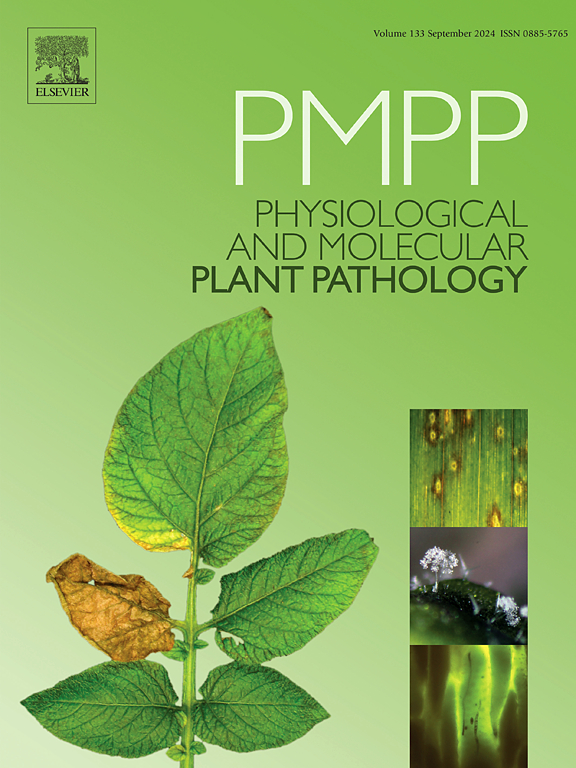植物提取物通过调节抗氧化酶活性诱导水稻抗白叶枯病
IF 2.8
3区 农林科学
Q2 PLANT SCIENCES
引用次数: 0
摘要
水稻白叶枯病是由水稻黄单胞菌引起的。稻瘟病(Xoo)被认为是危害水稻作物最严重的病害之一。过度使用合成杀菌剂来控制这种疾病会对周围环境产生负面影响。植物有各种各样的代谢物来抵抗植物病原体。因此,可持续农业需要一种有前途和环境友好的方法。叶面施用天然产物或化合物是提高植物抗病性的一种策略。该研究利用了具有多种药理活性的植物,包括墨西哥银莲花、蓝桉、冬莨菪、菲律宾马丽花和山葵,具有各种健康益处,如抗菌、抗病毒、皮肤学和伤口愈合特性。在这里,我们证明了叶面喷施不同植物的叶提取物可以诱导水稻对稻瘟弧菌的抗性。oryzae。从观察第3天到第12天,用提取物处理显著降低了细菌入侵。此外,处理叶片中较高的叶绿素A荧光表明光系统对Xoo损伤有ІІ保护作用。在处理后第3、6、9天,通过测定愈创木酚过氧化物酶、过氧化氢酶、超氧化酶歧化酶、谷胱甘肽还原酶等抗氧化酶的积累和总蛋白含量来评价抗性的发生。处理后叶片的抗氧化酶和蛋白质水平均高于对照,特别是在处理后第6天和第9天。胁迫相关损伤指标丙二醛(malondidehyde)在处理后第9天显著降低。此外,通过植物提取物中酚、单宁和黄酮类化合物浓度的增加,证实了可能有助于引发抗性的植物化学物质的存在。类似的结果也反映在它们的抗氧化能力上。最后,傅里叶变换红外光谱(FT-IR)分析证实了各种功能基团的存在,表明植物样品中存在不同的代谢物。因此,植物提取物对水稻叶片抗白叶枯病能力的增强可归因于抗触发效应。此外,在大范围内,植物提取物因其生物活性化合物而成为合成杀菌剂的可持续替代品,减少了对环境的影响和化学残留,并促进了对人类和非目标生物的更安全的做法。本文章由计算机程序翻译,如有差异,请以英文原文为准。
Plant extracts induce resistance in rice against bacterial blight disease by modulating antioxidant enzymes activity
Rice Bacterial Blight (BB), which is caused by Xanthomonas oryzae pv. oryzae (Xoo), is deemed as one of the most severe diseases that can afflict rice crops. Excessive use of synthetic bactericides to control this disease negatively impacts the surrounding environment. Plants have various metabolites that protect against phytopathogens. Thus, a promising and environment-friendly approach is needed for sustainable agriculture. Foliar application of natural products or compounds is one such strategy to enhance plant disease resistance. The study utilized plants with various pharmacological activities, including Argemone mexicana, Eucalyptus globulus, Bassia scoparia, Mallotus philippensis, and Shorea robusta, for various health benefits such as antibacterial, antiviral, dermatological, and wound healing property. Here, we demonstrate that foliar spray with the leaf extracts of different plants induces resistance in rice against X. oryzae pv. oryzae. Treatment with extracts significantly reduced the bacterial invasion from the 3rd to the 12th day of observation. Furthermore, higher chlorophyll A fluorescence in treated leaves indicates the photosystem's ІІ protection from Xoo damage. The resistance developed was evaluated by measuring the accumulation of antioxidant enzymes such as guaiacol peroxidase, catalase, superoxidase dismutase, glutathione reductase, and total protein content on the 3rd, 6th, and 9th day after treatment. Antioxidant enzymes and protein levels were higher in treated leaves than in the control, particularly on the 6th and 9th days after treatment. Malondialdehyde, an indicator of stress-related damage, was observed to be reduced in treated leaves on the 9th day. Additionally, the presence of phytochemicals that might help in triggering resistance was confirmed through an increased concentration of phenol, tannin, and flavonoids in the plant extract. Similar results were reflected in their antioxidant ability. Finally, Fourier transform-infrared spectroscopy (FT-IR) analysis confirms the presence of various functional groups, indicating distinct metabolites in the plant samples. Thus, the enhanced bacterial blight resistance in rice leaves treated with plant extracts can be attributed to the resistance-triggering effects. Further at large scale, plant extracts offer a sustainable alternative to synthetic bactericides due to their bioactive compounds, reducing environmental impact and chemical residues and promoting safer practices for humans and non-target organisms.
求助全文
通过发布文献求助,成功后即可免费获取论文全文。
去求助
来源期刊
CiteScore
4.30
自引率
7.40%
发文量
130
审稿时长
38 days
期刊介绍:
Physiological and Molecular Plant Pathology provides an International forum for original research papers, reviews, and commentaries on all aspects of the molecular biology, biochemistry, physiology, histology and cytology, genetics and evolution of plant-microbe interactions.
Papers on all kinds of infective pathogen, including viruses, prokaryotes, fungi, and nematodes, as well as mutualistic organisms such as Rhizobium and mycorrhyzal fungi, are acceptable as long as they have a bearing on the interaction between pathogen and plant.

 求助内容:
求助内容: 应助结果提醒方式:
应助结果提醒方式:


